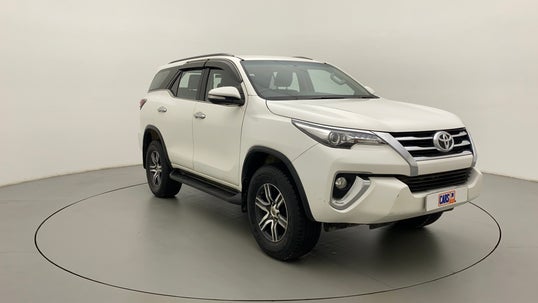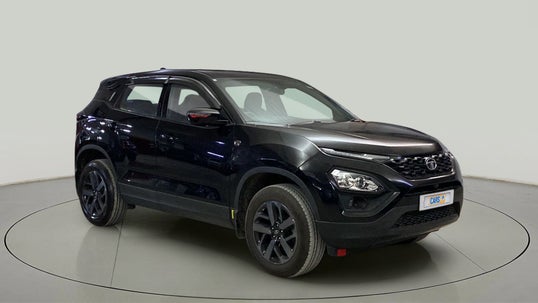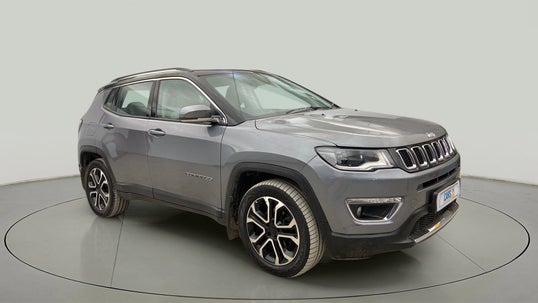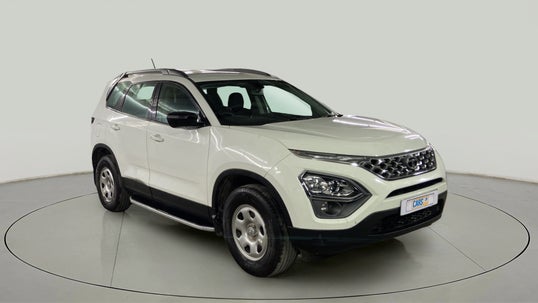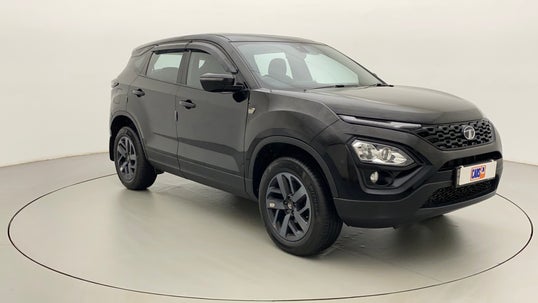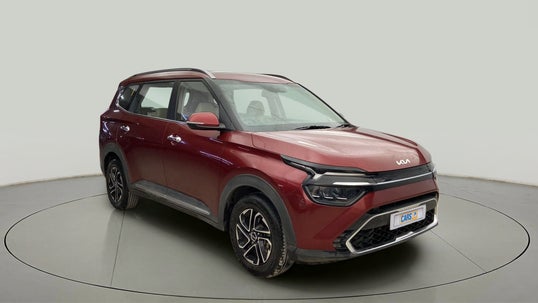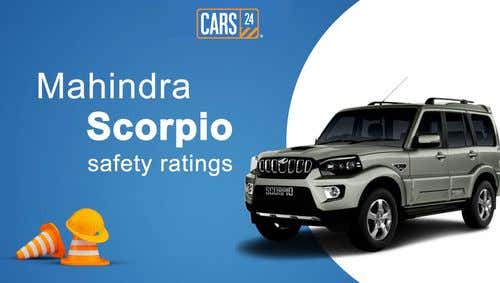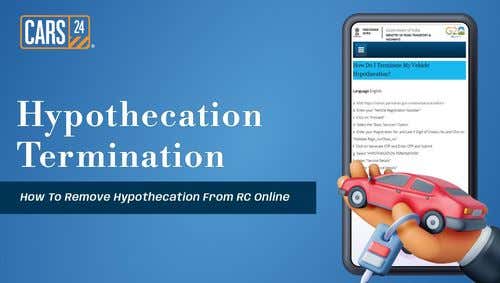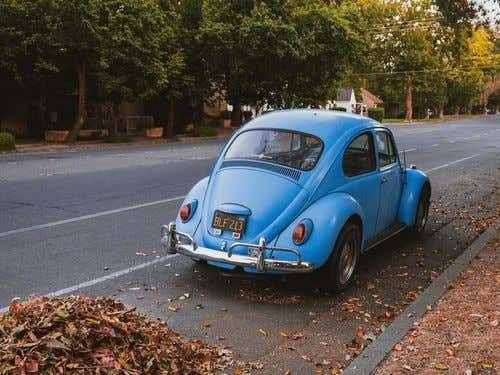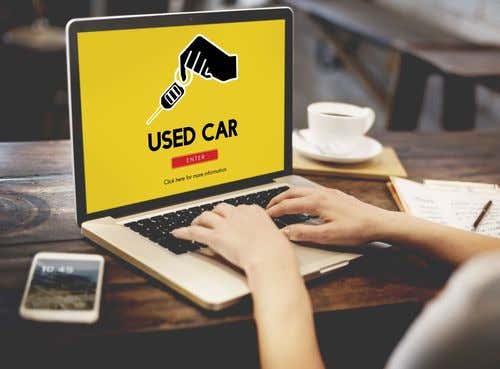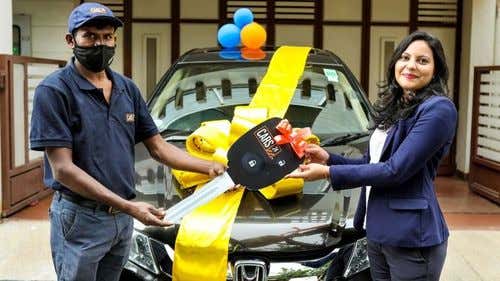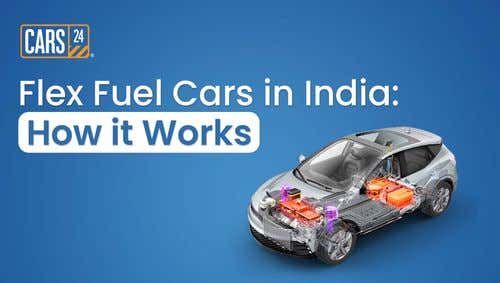The Essential List of Tools to Carry In Your Car Apart From Your Toolkit

Rahul Jha
Updated on: 10th January, 2024 IST
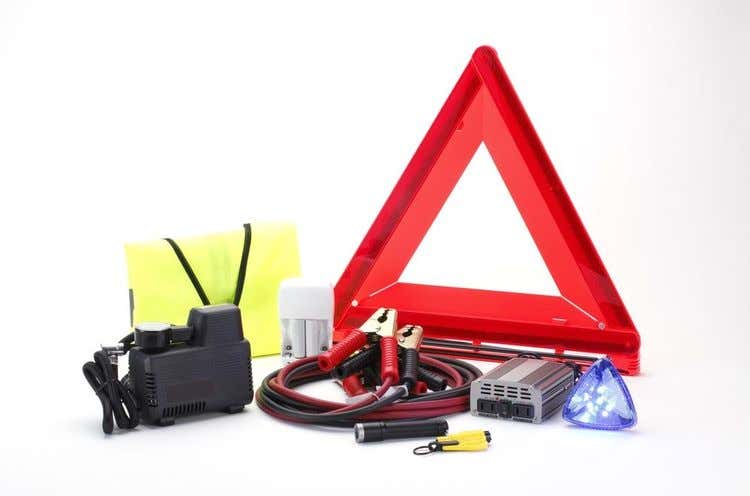
As a car owner, the possibilities for adventures or emergencies you might face on the road are endless. From a flat tyre to a dead battery, and low visibility to getting stuck in a ditch, it's important to be prepared for any situation. That's why we've put together a comprehensive list of some of the most essential tools to add to your vehicle tool kit list. The tools listed in this car tool kit list can help you stay safe, save time, and even save money in the long run.
If you're a novice, your vehicle tool kit list may contain some of the basic tools like a wrench and screwdriver, but there are a few more tools you need to carry in your car. Think of these tools as your best friend, always ready to save the day. From a durable flashlight to a well-curated first aid kit, we've got you covered with a list of the must have tools in your car.
Now that you know how important it is to carry a specialised toolkit for your car, you might have other questions. Like, "what tools should I keep in my car?" or "what comprises a basic car tool kit?" So, without further ado, let's answer all your questions and take a look at the essential tools to keep in your car:
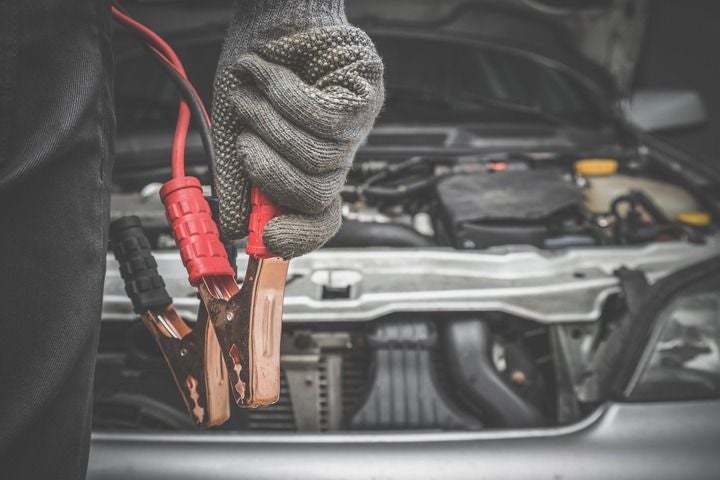 Carrying jumper cables can be lifesaving in case of a dead battery, which can happen unexpectedly. Even though jump-starting a car is a simple process, it is important to follow the correct procedure to avoid any accidents.
Firstly, make sure both cars are turned off and the jumper cables are untangled and ready to use. Then, attach the red clamp to the positive terminal of the dead battery, followed by the other red clamp to the positive terminal of the working battery. Next, attach the black clamp to the negative terminal of the working battery, and attach the other black clamp to an unpainted metal surface on the dead car, such as a bolt or bracket.
Finally, start the working car and let it run for a few minutes before attempting to start the dead car. Once the dead car has started, let both cars run for a few more minutes before disconnecting the cables in reverse order. It is important to handle the cables carefully and avoid touching the metal clamps together to prevent sparking.
Read More : What is the Difference Between Car Wax and Polish? Explained
Carrying jumper cables can be lifesaving in case of a dead battery, which can happen unexpectedly. Even though jump-starting a car is a simple process, it is important to follow the correct procedure to avoid any accidents.
Firstly, make sure both cars are turned off and the jumper cables are untangled and ready to use. Then, attach the red clamp to the positive terminal of the dead battery, followed by the other red clamp to the positive terminal of the working battery. Next, attach the black clamp to the negative terminal of the working battery, and attach the other black clamp to an unpainted metal surface on the dead car, such as a bolt or bracket.
Finally, start the working car and let it run for a few minutes before attempting to start the dead car. Once the dead car has started, let both cars run for a few more minutes before disconnecting the cables in reverse order. It is important to handle the cables carefully and avoid touching the metal clamps together to prevent sparking.
Read More : What is the Difference Between Car Wax and Polish? Explained
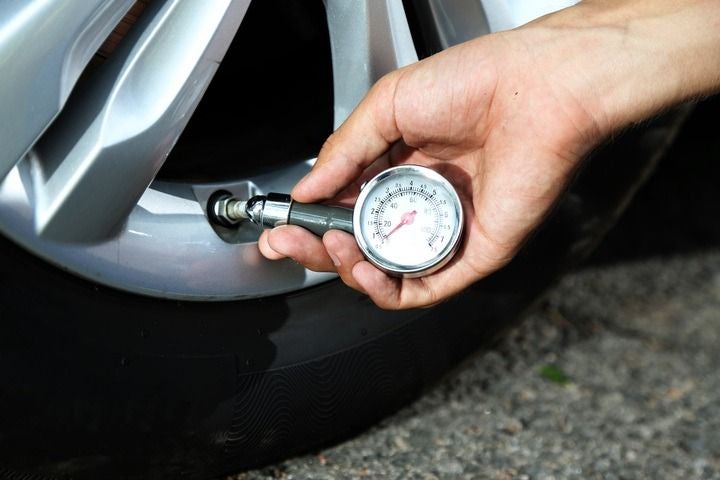 Maintaining proper tyre pressure is essential for a safe, efficient, and comfortable driving experience. Driving with underinflated or overinflated tyres can lead to poor handling, reduced fuel efficiency, and even result in irreversible tyre damage.
Checking your tyre pressure with a pressure gauge is a quick and easy way to ensure your tyres are properly inflated. To use a tyre pressure gauge, remove the valve cap from the tyre and press the gauge onto the valve stem until you hear a hissing sound. The gauge will display the tyre pressure reading, which should match the recommended pressure listed in your vehicle's owner manual or on the tyre placard located on the driver's door jamb.
If the pressure is too low, use an air compressor to add air to the tyre until it reaches the recommended pressure. If the pressure is too high, release some air until it reaches the recommended pressure.
Maintaining proper tyre pressure is essential for a safe, efficient, and comfortable driving experience. Driving with underinflated or overinflated tyres can lead to poor handling, reduced fuel efficiency, and even result in irreversible tyre damage.
Checking your tyre pressure with a pressure gauge is a quick and easy way to ensure your tyres are properly inflated. To use a tyre pressure gauge, remove the valve cap from the tyre and press the gauge onto the valve stem until you hear a hissing sound. The gauge will display the tyre pressure reading, which should match the recommended pressure listed in your vehicle's owner manual or on the tyre placard located on the driver's door jamb.
If the pressure is too low, use an air compressor to add air to the tyre until it reaches the recommended pressure. If the pressure is too high, release some air until it reaches the recommended pressure.
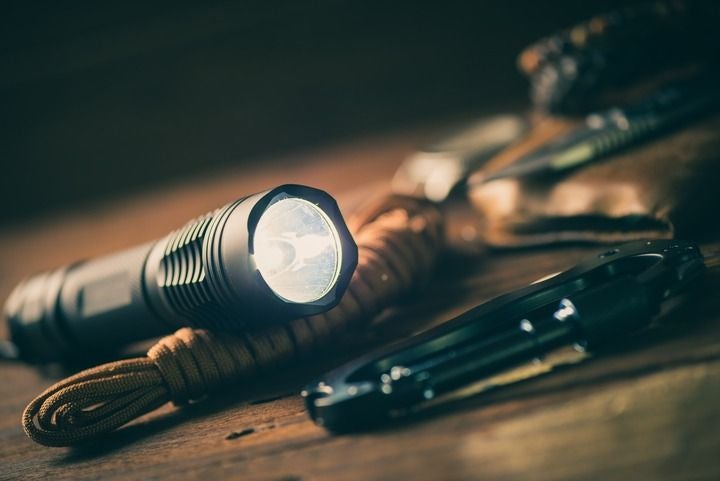 Carrying a flashlight is immensely important in case of an emergency or breakdown at night, as it helps you see and be seen by other drivers. A durable, reliable, waterproof, and shockproof LED flashlight should be one of your top priorities.
The flashlight should be bright, must have a long battery life, and should be easily accessible in the car. In addition to using the flashlight for emergencies, it can also come in handy for everyday tasks such as searching for misplaced items in the car cabin or reading a map in low light conditions. It is important to check the batteries regularly and replace them before going for a long drive to ensure the flashlight is always ready to use.
Read More : Tips on How to Effectively Use Your Car AC this SUMMER!
Carrying a flashlight is immensely important in case of an emergency or breakdown at night, as it helps you see and be seen by other drivers. A durable, reliable, waterproof, and shockproof LED flashlight should be one of your top priorities.
The flashlight should be bright, must have a long battery life, and should be easily accessible in the car. In addition to using the flashlight for emergencies, it can also come in handy for everyday tasks such as searching for misplaced items in the car cabin or reading a map in low light conditions. It is important to check the batteries regularly and replace them before going for a long drive to ensure the flashlight is always ready to use.
Read More : Tips on How to Effectively Use Your Car AC this SUMMER!
 The importance of a first aid kit can never be stressed enough. A first aid kit is an essential item that every car owner should have in case of any minor injuries while on the road.
In case of an accident, a first aid kit can make a life-saving difference in the time it takes to treat injuries and consult a physician. A basic first aid kit should contain adhesive bandages, sterile gauze pads, cotton balls, antiseptic wipes, scissors, tweezers, a bunch of face masks, and a thermometer.
It's also a good idea to include medications for pain relief, antihistamines, Loperamide (to treat stomach issues), and a leaflet with basic first-aid instructions. Make sure to check and restock the first aid kit periodically to ensure that all items are in good condition and not expired.
Also Read: Types of Chassis
The importance of a first aid kit can never be stressed enough. A first aid kit is an essential item that every car owner should have in case of any minor injuries while on the road.
In case of an accident, a first aid kit can make a life-saving difference in the time it takes to treat injuries and consult a physician. A basic first aid kit should contain adhesive bandages, sterile gauze pads, cotton balls, antiseptic wipes, scissors, tweezers, a bunch of face masks, and a thermometer.
It's also a good idea to include medications for pain relief, antihistamines, Loperamide (to treat stomach issues), and a leaflet with basic first-aid instructions. Make sure to check and restock the first aid kit periodically to ensure that all items are in good condition and not expired.
Also Read: Types of Chassis
 A warm blanket is another essential item to keep in your car, especially when you're travelling during the winter months. In case of a breakdown or an emergency, a blanket can keep you warm and prevent hypothermia.
The blanket can also be used as a makeshift shelter in case you are stranded outdoors. A heavy-duty wool or fleece blanket is a good choice, as they are both durable and warm. It's also a good idea to keep an extra set of warm clothing in your car, such as a jacket, gloves, and hat.
Read More : When Should I Replace My Car Brake Pads?
A warm blanket is another essential item to keep in your car, especially when you're travelling during the winter months. In case of a breakdown or an emergency, a blanket can keep you warm and prevent hypothermia.
The blanket can also be used as a makeshift shelter in case you are stranded outdoors. A heavy-duty wool or fleece blanket is a good choice, as they are both durable and warm. It's also a good idea to keep an extra set of warm clothing in your car, such as a jacket, gloves, and hat.
Read More : When Should I Replace My Car Brake Pads?
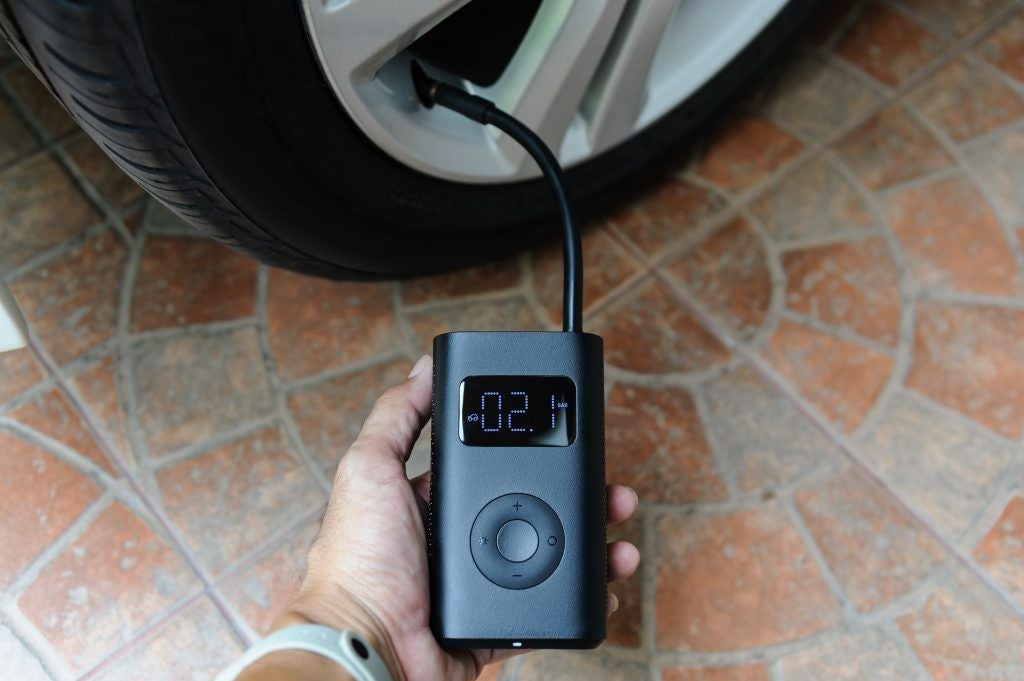 Carrying a portable air compressor in your car can save you a lot of trouble in case of a flat tyre or low tyre pressure. Instead of searching for a nearby fuel station to inflate your tyre, you can quickly and easily inflate your tyre using the air compressor.
A portable air compressor should be compact and easy to use. It should also come with a pressure gauge and an automatic shut-off feature to prevent over-inflating the tyre.
Remember to periodically check your tyre pressure and inflate your tyres to the recommended level to ensure optimal performance and safety while driving.
Carrying a portable air compressor in your car can save you a lot of trouble in case of a flat tyre or low tyre pressure. Instead of searching for a nearby fuel station to inflate your tyre, you can quickly and easily inflate your tyre using the air compressor.
A portable air compressor should be compact and easy to use. It should also come with a pressure gauge and an automatic shut-off feature to prevent over-inflating the tyre.
Remember to periodically check your tyre pressure and inflate your tyres to the recommended level to ensure optimal performance and safety while driving.
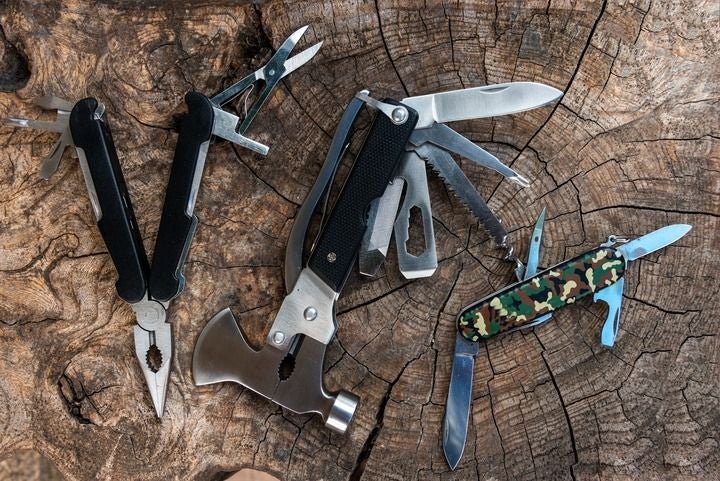 A multipurpose tool, such as a Swiss Army Knife or a Leatherman tool, can be a life-saving accessory in a variety of situations. These tools are compact and come equipped with a range of features and attachments, from pliers and screwdrivers to scissors and can openers. They can help you undertake small repairs without the need for an extensive tool kit.
In an emergency, a multipurpose tool can be particularly useful. Whether you need to cut a seatbelt, tighten a loose screw or open a bottle of water, you can rely on this tool to help you out.
A multipurpose tool, such as a Swiss Army Knife or a Leatherman tool, can be a life-saving accessory in a variety of situations. These tools are compact and come equipped with a range of features and attachments, from pliers and screwdrivers to scissors and can openers. They can help you undertake small repairs without the need for an extensive tool kit.
In an emergency, a multipurpose tool can be particularly useful. Whether you need to cut a seatbelt, tighten a loose screw or open a bottle of water, you can rely on this tool to help you out.
 Another essential item to keep in your car is reflective triangles or flares. In case of an accident or a breakdown, it's important to alert other drivers to the situation.
Reflective triangles or flares can help you warn other drivers of your presence on the road. These items are especially important if you're stopped on the side of a busy highway or in low visibility conditions. It's recommended to keep at least three reflective triangles or flares in your car and to set them up at increasing distances from your car to give other drivers ample warning.
Another essential item to keep in your car is reflective triangles or flares. In case of an accident or a breakdown, it's important to alert other drivers to the situation.
Reflective triangles or flares can help you warn other drivers of your presence on the road. These items are especially important if you're stopped on the side of a busy highway or in low visibility conditions. It's recommended to keep at least three reflective triangles or flares in your car and to set them up at increasing distances from your car to give other drivers ample warning.
 Duct tape is a versatile and multi-purpose tool that should be a staple in every car emergency kit. Whether you need to repair a side-view mirror, secure a broken taillight or even patch up a torn seat, duct tape can do the job.
It's strong, durable and easy to tear, making it a convenient tool for a range of situations. It is recommended to choose duct tape that can withstand extreme temperatures and moisture.
Duct tape is a versatile and multi-purpose tool that should be a staple in every car emergency kit. Whether you need to repair a side-view mirror, secure a broken taillight or even patch up a torn seat, duct tape can do the job.
It's strong, durable and easy to tear, making it a convenient tool for a range of situations. It is recommended to choose duct tape that can withstand extreme temperatures and moisture.
 When you're on the road, there's always a possibility for some impromptu repair work on your car. In such situations, one tool that you shouldn't overlook is a pair of cut-proof work gloves.
These gloves are designed to protect your hands when you're working on your car. They're made from a special cut-resistant material that can withstand sharp edges that you might encounter under the hood. This means you can work on your car without having to worry about injuring your hands or fingers.
Not only do these gloves offer protection, but they can also improve your grip and dexterity. This makes it easier to work with small parts and intricate components. And, because they're lightweight and comfortable to wear, you can keep them on for extended periods without experiencing any discomfort.
When you're on the road, there's always a possibility for some impromptu repair work on your car. In such situations, one tool that you shouldn't overlook is a pair of cut-proof work gloves.
These gloves are designed to protect your hands when you're working on your car. They're made from a special cut-resistant material that can withstand sharp edges that you might encounter under the hood. This means you can work on your car without having to worry about injuring your hands or fingers.
Not only do these gloves offer protection, but they can also improve your grip and dexterity. This makes it easier to work with small parts and intricate components. And, because they're lightweight and comfortable to wear, you can keep them on for extended periods without experiencing any discomfort.
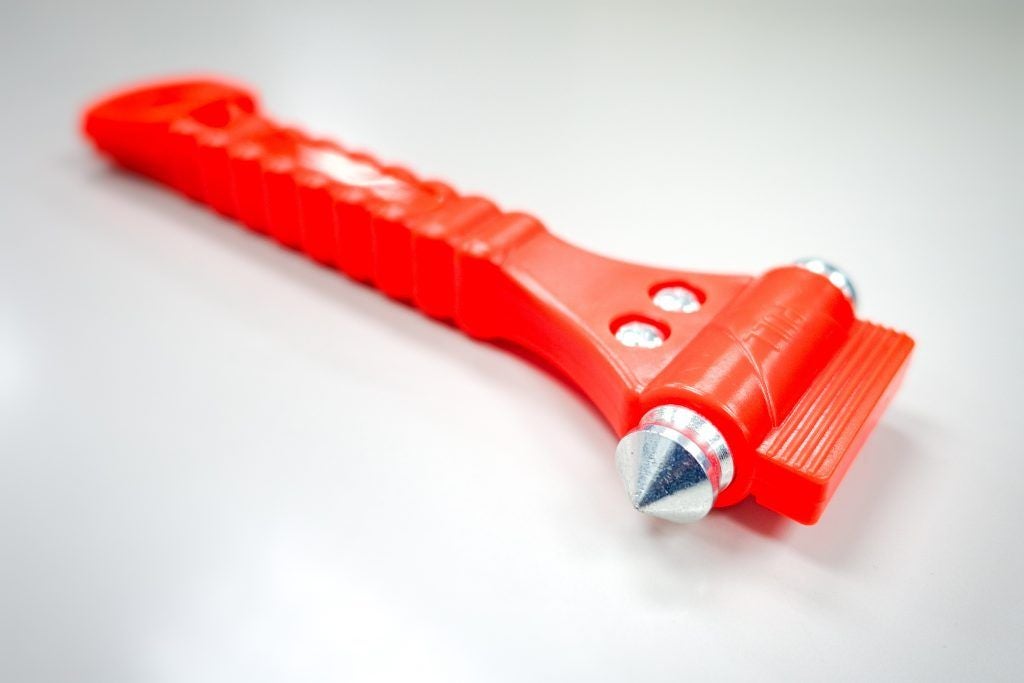 A LifeHammer can prove to be a life-saving tool in an emergency. If you are ever trapped in your car after an accident or a collision, a LifeHammer can help you escape to safety. It comes equipped with a sharp steel point that can shatter car windows and a seatbelt cutter to cut through jammed seat belts. Make sure you keep it in a readily accessible location within your vehicle.
A LifeHammer can prove to be a life-saving tool in an emergency. If you are ever trapped in your car after an accident or a collision, a LifeHammer can help you escape to safety. It comes equipped with a sharp steel point that can shatter car windows and a seatbelt cutter to cut through jammed seat belts. Make sure you keep it in a readily accessible location within your vehicle.
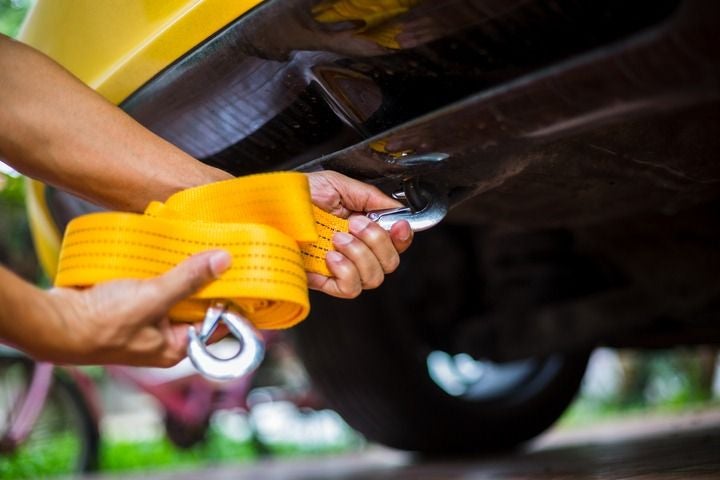 Getting stuck in mud, snow, or sand is frustrating and can take a toll on your health and safety. A tow strap can be a lifesaver in such situations. A high-quality tow strap is a durable and reliable tool that can help you pull your car out of a sticky situation. When selecting a tow strap, ensure it can handle the weight of your vehicle and has sufficient length to reach a secure anchor point.
Getting stuck in mud, snow, or sand is frustrating and can take a toll on your health and safety. A tow strap can be a lifesaver in such situations. A high-quality tow strap is a durable and reliable tool that can help you pull your car out of a sticky situation. When selecting a tow strap, ensure it can handle the weight of your vehicle and has sufficient length to reach a secure anchor point.
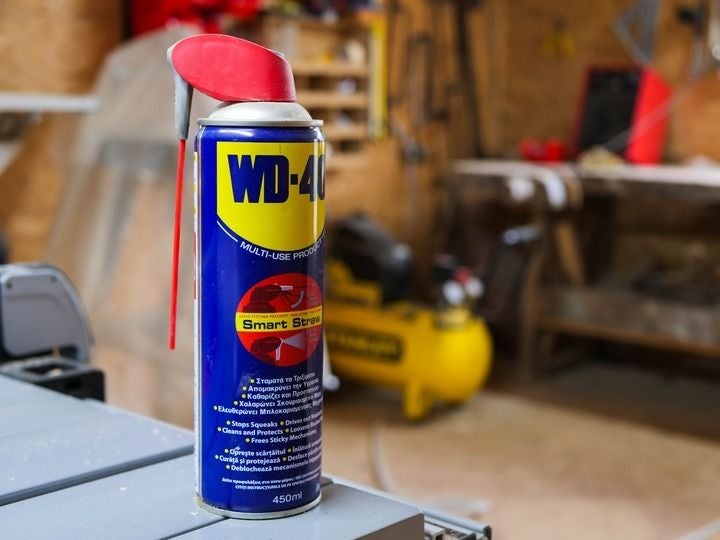 WD-40 is a versatile spray lubricant that can be used for a wide range of purposes. It can help loosen rusted bolts, prevent corrosion, lubricate hinges, and displace any traces of moisture from harder-to-access nooks and crannies. It can even be used to clean and shine your car. Keeping a can of WD-40 in your car can come in handy in various situations.
WD-40 is a versatile spray lubricant that can be used for a wide range of purposes. It can help loosen rusted bolts, prevent corrosion, lubricate hinges, and displace any traces of moisture from harder-to-access nooks and crannies. It can even be used to clean and shine your car. Keeping a can of WD-40 in your car can come in handy in various situations.
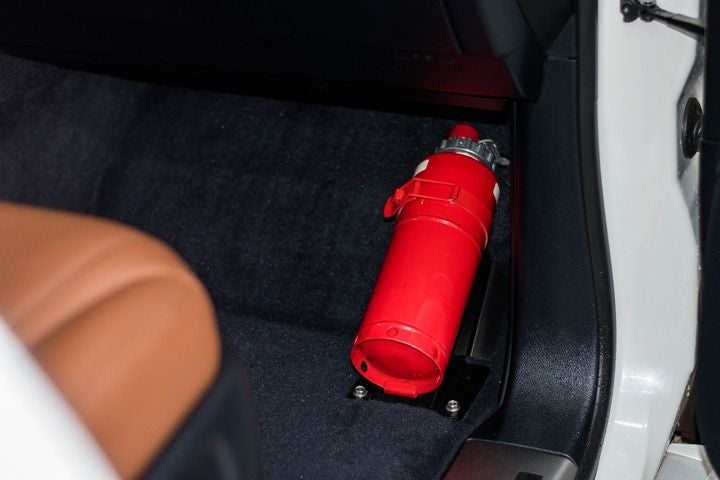 A fire can break out anytime, anywhere, and in any vehicle. Having a portable fire extinguisher in your car can help you quickly put out a small fire or contain it until the fire department arrives. Ensure the fire extinguisher you choose is rated for automotive fires and is within reach of the driver's seat.
A fire can break out anytime, anywhere, and in any vehicle. Having a portable fire extinguisher in your car can help you quickly put out a small fire or contain it until the fire department arrives. Ensure the fire extinguisher you choose is rated for automotive fires and is within reach of the driver's seat.
Table of Contents
1. Jumper cables
 Carrying jumper cables can be lifesaving in case of a dead battery, which can happen unexpectedly. Even though jump-starting a car is a simple process, it is important to follow the correct procedure to avoid any accidents.
Firstly, make sure both cars are turned off and the jumper cables are untangled and ready to use. Then, attach the red clamp to the positive terminal of the dead battery, followed by the other red clamp to the positive terminal of the working battery. Next, attach the black clamp to the negative terminal of the working battery, and attach the other black clamp to an unpainted metal surface on the dead car, such as a bolt or bracket.
Finally, start the working car and let it run for a few minutes before attempting to start the dead car. Once the dead car has started, let both cars run for a few more minutes before disconnecting the cables in reverse order. It is important to handle the cables carefully and avoid touching the metal clamps together to prevent sparking.
Read More : What is the Difference Between Car Wax and Polish? Explained
Carrying jumper cables can be lifesaving in case of a dead battery, which can happen unexpectedly. Even though jump-starting a car is a simple process, it is important to follow the correct procedure to avoid any accidents.
Firstly, make sure both cars are turned off and the jumper cables are untangled and ready to use. Then, attach the red clamp to the positive terminal of the dead battery, followed by the other red clamp to the positive terminal of the working battery. Next, attach the black clamp to the negative terminal of the working battery, and attach the other black clamp to an unpainted metal surface on the dead car, such as a bolt or bracket.
Finally, start the working car and let it run for a few minutes before attempting to start the dead car. Once the dead car has started, let both cars run for a few more minutes before disconnecting the cables in reverse order. It is important to handle the cables carefully and avoid touching the metal clamps together to prevent sparking.
Read More : What is the Difference Between Car Wax and Polish? Explained
2. Tyre pressure gauge
 Maintaining proper tyre pressure is essential for a safe, efficient, and comfortable driving experience. Driving with underinflated or overinflated tyres can lead to poor handling, reduced fuel efficiency, and even result in irreversible tyre damage.
Checking your tyre pressure with a pressure gauge is a quick and easy way to ensure your tyres are properly inflated. To use a tyre pressure gauge, remove the valve cap from the tyre and press the gauge onto the valve stem until you hear a hissing sound. The gauge will display the tyre pressure reading, which should match the recommended pressure listed in your vehicle's owner manual or on the tyre placard located on the driver's door jamb.
If the pressure is too low, use an air compressor to add air to the tyre until it reaches the recommended pressure. If the pressure is too high, release some air until it reaches the recommended pressure.
Maintaining proper tyre pressure is essential for a safe, efficient, and comfortable driving experience. Driving with underinflated or overinflated tyres can lead to poor handling, reduced fuel efficiency, and even result in irreversible tyre damage.
Checking your tyre pressure with a pressure gauge is a quick and easy way to ensure your tyres are properly inflated. To use a tyre pressure gauge, remove the valve cap from the tyre and press the gauge onto the valve stem until you hear a hissing sound. The gauge will display the tyre pressure reading, which should match the recommended pressure listed in your vehicle's owner manual or on the tyre placard located on the driver's door jamb.
If the pressure is too low, use an air compressor to add air to the tyre until it reaches the recommended pressure. If the pressure is too high, release some air until it reaches the recommended pressure.
3. Flashlight
 Carrying a flashlight is immensely important in case of an emergency or breakdown at night, as it helps you see and be seen by other drivers. A durable, reliable, waterproof, and shockproof LED flashlight should be one of your top priorities.
The flashlight should be bright, must have a long battery life, and should be easily accessible in the car. In addition to using the flashlight for emergencies, it can also come in handy for everyday tasks such as searching for misplaced items in the car cabin or reading a map in low light conditions. It is important to check the batteries regularly and replace them before going for a long drive to ensure the flashlight is always ready to use.
Read More : Tips on How to Effectively Use Your Car AC this SUMMER!
Carrying a flashlight is immensely important in case of an emergency or breakdown at night, as it helps you see and be seen by other drivers. A durable, reliable, waterproof, and shockproof LED flashlight should be one of your top priorities.
The flashlight should be bright, must have a long battery life, and should be easily accessible in the car. In addition to using the flashlight for emergencies, it can also come in handy for everyday tasks such as searching for misplaced items in the car cabin or reading a map in low light conditions. It is important to check the batteries regularly and replace them before going for a long drive to ensure the flashlight is always ready to use.
Read More : Tips on How to Effectively Use Your Car AC this SUMMER!
4. First aid kit
 The importance of a first aid kit can never be stressed enough. A first aid kit is an essential item that every car owner should have in case of any minor injuries while on the road.
In case of an accident, a first aid kit can make a life-saving difference in the time it takes to treat injuries and consult a physician. A basic first aid kit should contain adhesive bandages, sterile gauze pads, cotton balls, antiseptic wipes, scissors, tweezers, a bunch of face masks, and a thermometer.
It's also a good idea to include medications for pain relief, antihistamines, Loperamide (to treat stomach issues), and a leaflet with basic first-aid instructions. Make sure to check and restock the first aid kit periodically to ensure that all items are in good condition and not expired.
Also Read: Types of Chassis
The importance of a first aid kit can never be stressed enough. A first aid kit is an essential item that every car owner should have in case of any minor injuries while on the road.
In case of an accident, a first aid kit can make a life-saving difference in the time it takes to treat injuries and consult a physician. A basic first aid kit should contain adhesive bandages, sterile gauze pads, cotton balls, antiseptic wipes, scissors, tweezers, a bunch of face masks, and a thermometer.
It's also a good idea to include medications for pain relief, antihistamines, Loperamide (to treat stomach issues), and a leaflet with basic first-aid instructions. Make sure to check and restock the first aid kit periodically to ensure that all items are in good condition and not expired.
Also Read: Types of Chassis
5. Blanket
 A warm blanket is another essential item to keep in your car, especially when you're travelling during the winter months. In case of a breakdown or an emergency, a blanket can keep you warm and prevent hypothermia.
The blanket can also be used as a makeshift shelter in case you are stranded outdoors. A heavy-duty wool or fleece blanket is a good choice, as they are both durable and warm. It's also a good idea to keep an extra set of warm clothing in your car, such as a jacket, gloves, and hat.
Read More : When Should I Replace My Car Brake Pads?
A warm blanket is another essential item to keep in your car, especially when you're travelling during the winter months. In case of a breakdown or an emergency, a blanket can keep you warm and prevent hypothermia.
The blanket can also be used as a makeshift shelter in case you are stranded outdoors. A heavy-duty wool or fleece blanket is a good choice, as they are both durable and warm. It's also a good idea to keep an extra set of warm clothing in your car, such as a jacket, gloves, and hat.
Read More : When Should I Replace My Car Brake Pads?
6. Portable air compressor
 Carrying a portable air compressor in your car can save you a lot of trouble in case of a flat tyre or low tyre pressure. Instead of searching for a nearby fuel station to inflate your tyre, you can quickly and easily inflate your tyre using the air compressor.
A portable air compressor should be compact and easy to use. It should also come with a pressure gauge and an automatic shut-off feature to prevent over-inflating the tyre.
Remember to periodically check your tyre pressure and inflate your tyres to the recommended level to ensure optimal performance and safety while driving.
Carrying a portable air compressor in your car can save you a lot of trouble in case of a flat tyre or low tyre pressure. Instead of searching for a nearby fuel station to inflate your tyre, you can quickly and easily inflate your tyre using the air compressor.
A portable air compressor should be compact and easy to use. It should also come with a pressure gauge and an automatic shut-off feature to prevent over-inflating the tyre.
Remember to periodically check your tyre pressure and inflate your tyres to the recommended level to ensure optimal performance and safety while driving.
7. Multipurpose tool
 A multipurpose tool, such as a Swiss Army Knife or a Leatherman tool, can be a life-saving accessory in a variety of situations. These tools are compact and come equipped with a range of features and attachments, from pliers and screwdrivers to scissors and can openers. They can help you undertake small repairs without the need for an extensive tool kit.
In an emergency, a multipurpose tool can be particularly useful. Whether you need to cut a seatbelt, tighten a loose screw or open a bottle of water, you can rely on this tool to help you out.
A multipurpose tool, such as a Swiss Army Knife or a Leatherman tool, can be a life-saving accessory in a variety of situations. These tools are compact and come equipped with a range of features and attachments, from pliers and screwdrivers to scissors and can openers. They can help you undertake small repairs without the need for an extensive tool kit.
In an emergency, a multipurpose tool can be particularly useful. Whether you need to cut a seatbelt, tighten a loose screw or open a bottle of water, you can rely on this tool to help you out.
8. Reflective triangles or flares
 Another essential item to keep in your car is reflective triangles or flares. In case of an accident or a breakdown, it's important to alert other drivers to the situation.
Reflective triangles or flares can help you warn other drivers of your presence on the road. These items are especially important if you're stopped on the side of a busy highway or in low visibility conditions. It's recommended to keep at least three reflective triangles or flares in your car and to set them up at increasing distances from your car to give other drivers ample warning.
Another essential item to keep in your car is reflective triangles or flares. In case of an accident or a breakdown, it's important to alert other drivers to the situation.
Reflective triangles or flares can help you warn other drivers of your presence on the road. These items are especially important if you're stopped on the side of a busy highway or in low visibility conditions. It's recommended to keep at least three reflective triangles or flares in your car and to set them up at increasing distances from your car to give other drivers ample warning.
9. Duct tape
 Duct tape is a versatile and multi-purpose tool that should be a staple in every car emergency kit. Whether you need to repair a side-view mirror, secure a broken taillight or even patch up a torn seat, duct tape can do the job.
It's strong, durable and easy to tear, making it a convenient tool for a range of situations. It is recommended to choose duct tape that can withstand extreme temperatures and moisture.
Duct tape is a versatile and multi-purpose tool that should be a staple in every car emergency kit. Whether you need to repair a side-view mirror, secure a broken taillight or even patch up a torn seat, duct tape can do the job.
It's strong, durable and easy to tear, making it a convenient tool for a range of situations. It is recommended to choose duct tape that can withstand extreme temperatures and moisture.
10. Cut-proof gloves
 When you're on the road, there's always a possibility for some impromptu repair work on your car. In such situations, one tool that you shouldn't overlook is a pair of cut-proof work gloves.
These gloves are designed to protect your hands when you're working on your car. They're made from a special cut-resistant material that can withstand sharp edges that you might encounter under the hood. This means you can work on your car without having to worry about injuring your hands or fingers.
Not only do these gloves offer protection, but they can also improve your grip and dexterity. This makes it easier to work with small parts and intricate components. And, because they're lightweight and comfortable to wear, you can keep them on for extended periods without experiencing any discomfort.
When you're on the road, there's always a possibility for some impromptu repair work on your car. In such situations, one tool that you shouldn't overlook is a pair of cut-proof work gloves.
These gloves are designed to protect your hands when you're working on your car. They're made from a special cut-resistant material that can withstand sharp edges that you might encounter under the hood. This means you can work on your car without having to worry about injuring your hands or fingers.
Not only do these gloves offer protection, but they can also improve your grip and dexterity. This makes it easier to work with small parts and intricate components. And, because they're lightweight and comfortable to wear, you can keep them on for extended periods without experiencing any discomfort.
11. LifeHammer
 A LifeHammer can prove to be a life-saving tool in an emergency. If you are ever trapped in your car after an accident or a collision, a LifeHammer can help you escape to safety. It comes equipped with a sharp steel point that can shatter car windows and a seatbelt cutter to cut through jammed seat belts. Make sure you keep it in a readily accessible location within your vehicle.
A LifeHammer can prove to be a life-saving tool in an emergency. If you are ever trapped in your car after an accident or a collision, a LifeHammer can help you escape to safety. It comes equipped with a sharp steel point that can shatter car windows and a seatbelt cutter to cut through jammed seat belts. Make sure you keep it in a readily accessible location within your vehicle.
12. Tow Strap
 Getting stuck in mud, snow, or sand is frustrating and can take a toll on your health and safety. A tow strap can be a lifesaver in such situations. A high-quality tow strap is a durable and reliable tool that can help you pull your car out of a sticky situation. When selecting a tow strap, ensure it can handle the weight of your vehicle and has sufficient length to reach a secure anchor point.
Getting stuck in mud, snow, or sand is frustrating and can take a toll on your health and safety. A tow strap can be a lifesaver in such situations. A high-quality tow strap is a durable and reliable tool that can help you pull your car out of a sticky situation. When selecting a tow strap, ensure it can handle the weight of your vehicle and has sufficient length to reach a secure anchor point.
13. WD-40
 WD-40 is a versatile spray lubricant that can be used for a wide range of purposes. It can help loosen rusted bolts, prevent corrosion, lubricate hinges, and displace any traces of moisture from harder-to-access nooks and crannies. It can even be used to clean and shine your car. Keeping a can of WD-40 in your car can come in handy in various situations.
WD-40 is a versatile spray lubricant that can be used for a wide range of purposes. It can help loosen rusted bolts, prevent corrosion, lubricate hinges, and displace any traces of moisture from harder-to-access nooks and crannies. It can even be used to clean and shine your car. Keeping a can of WD-40 in your car can come in handy in various situations.
14. Portable Fire Extinguisher
 A fire can break out anytime, anywhere, and in any vehicle. Having a portable fire extinguisher in your car can help you quickly put out a small fire or contain it until the fire department arrives. Ensure the fire extinguisher you choose is rated for automotive fires and is within reach of the driver's seat.
A fire can break out anytime, anywhere, and in any vehicle. Having a portable fire extinguisher in your car can help you quickly put out a small fire or contain it until the fire department arrives. Ensure the fire extinguisher you choose is rated for automotive fires and is within reach of the driver's seat.
Conclusion
As we conclude this blog on some of the top essential tools to carry in your car apart from your toolkit, we hope that you have gained valuable insights into the importance of being prepared for any unexpected situation on the road. Whether it's a flat tyre, a dead battery, or a minor accident, having the right tools on hand can make all the difference in ensuring your safety and getting you back on the road quickly. We highly recommend that you invest in high-quality and durable tools that can withstand the wear and tear of being in a car for extended periods. It is also crucial to check and maintain these tools regularly to ensure that they are in good working condition when you need them the most.FAQ’s:
Q. What tools should I keep in my car for emergencies?A.
You should keep tools like jumper cables, tyre pressure gauge, flashlight, first aid kit, blanket, multipurpose tool, reflective triangles/flares, duct tape, LifeHammer, tow strap, WD-40, and a portable fire extinguisher in your car for emergencies. Q. What is the most important tool in automotive?A.
A tyre pressure gauge is one of the most important tools as it helps in maintaining proper tyre pressure and ensures better handling, fuel efficiency and safety. Q. What are some tools car enthusiasts must-have for home auto repair?A.
Car enthusiasts must-have tools like socket and wrench sets, pliers, screwdrivers, torque wrenches, car jacks and stands for home auto repair.Recently Added Cars to Buy
Other Blogs
- Recent
- Featured
Popular Cities to Sell Car


